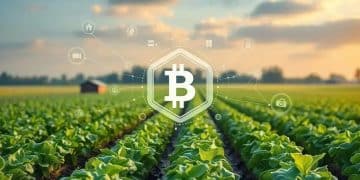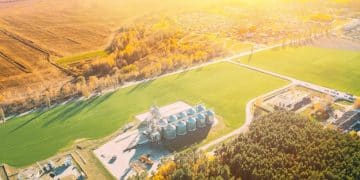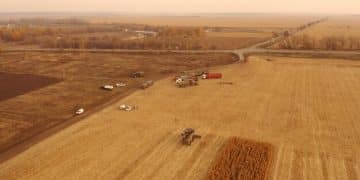Blockchain in Agriculture: Improving Food Traceability and Transparency
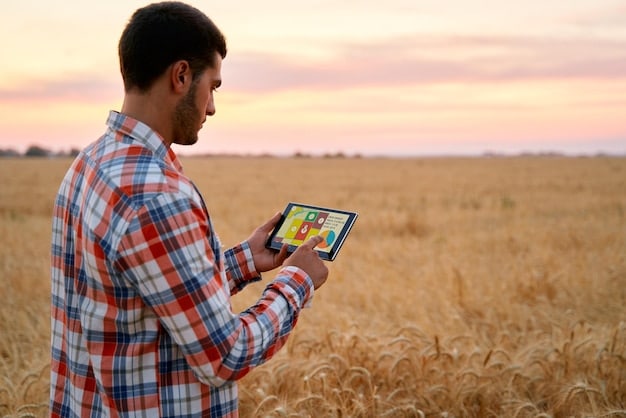
Blockchain technology in agriculture enhances traceability and transparency throughout the food supply chain, providing consumers with verifiable information on product origin, quality, and safety.
The journey of our food from farm to table is often complex and opaque. Blockchain technology in agriculture: Enhancing traceability and transparency in the food supply chain is changing that by offering a secure, transparent, and traceable system that could revolutionize how we track and manage food products.
Understanding blockchain technology in agriculture
Blockchain, at its core, is a distributed, decentralized, public ledger. Think of it as a digital record-keeping system that everyone can access but no single person controls. When it comes to agricultural supply chains, this technology can offer unprecedented levels of traceability and transparency.
Let’s delve deeper into what makes blockchain a game-changer for agriculture.
What is blockchain and how does it work?
Blockchain operates on a network of computers, each holding a copy of the ledger. When a transaction occurs – for example, a farmer selling produce to a distributor – it’s grouped together with other transactions into a “block.” This block is then cryptographically sealed and added to the chain.
Each block contains a “hash,” a unique fingerprint of the previous block, creating a chain of blocks that are linked together chronologically and securely. This makes the data tamper-proof, as altering any block would require changing all subsequent blocks, which is virtually impossible on a large, decentralized network.
Key benefits of blockchain in agriculture
The potential advantages are quite significant. These include:
- Improved traceability: Track products from farm to consumer.
- Enhanced transparency: Provide consumers with verifiable information.
- Increased efficiency: Streamline processes and reduce paperwork.
- Reduced fraud: Prevent counterfeiting and adulteration.
In essence, blockchain provides a trusted system for all parties involved in the food supply chain, from producers to consumers.
In conclusion, blockchain technology provides a robust and transparent framework that could transform the agricultural sector by enhancing traceability, improving efficiency, and increasing consumer trust.
Enhancing traceability in the food supply chain
One of the most significant applications of blockchain in agriculture is its ability to enhance traceability. Consumers increasingly demand to know where their food comes from, how it was produced, and whether it meets certain quality standards. Blockchain can provide this information with unparalleled accuracy.
Let’s explore how this technology can make a real difference.
Tracking from farm to table
Imagine a scenario where each step in the food supply chain is recorded on a blockchain. When a farmer harvests their crops, they can enter data about the product, such as its origin, harvest date, and any treatments used. This information is stored in a block on the blockchain.
As the product moves through the supply chain – from the farm to the processor, distributor, retailer, and finally, the consumer – each entity can add their own data to the blockchain. This creates an immutable record of the product’s entire journey.
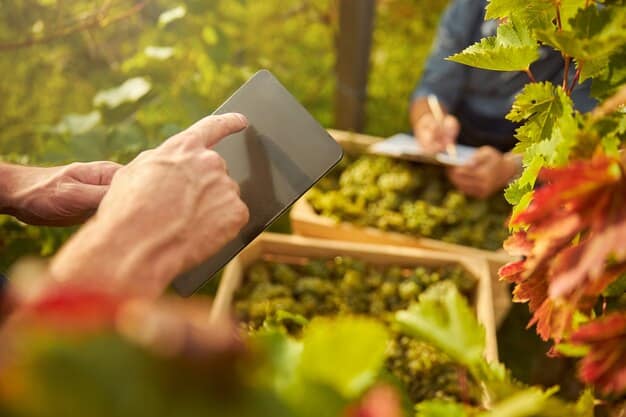
Real-world examples of traceability solutions
Several companies are already using blockchain to track agricultural products. For example, Walmart has implemented a blockchain-based system to track mangoes from farm to store. This allows them to trace the origin of any mango within seconds, which could take days using traditional methods.
Other examples include:
- IBM Food Trust: A blockchain platform used by various food companies to track products like coffee, seafood, and poultry.
- VeChain: Provides blockchain solutions for tracking products in the agriculture and food industries.
- OriginTrail: Focuses on supply chain solutions for various industries, including food and agriculture.
These initiatives demonstrate the practical benefits of blockchain in enhancing traceability and ensuring food safety.
In conclusion, blockchain substantially improves traceability in the food supply chain, providing consumers with verifiable information about the origin and journey of their food, thus enhancing food safety and consumer confidence.
Improving transparency for consumers and producers
Transparency is becoming increasingly important to both consumers and producers in the agricultural sector. Consumers want to know more about the food they are buying, including its origins, production methods, and environmental impact. Producers, on the other hand, can benefit from increased transparency by building trust with consumers and differentiating their products in the marketplace.
Here’s how blockchain steps in.
Building trust through transparency
Blockchain can provide consumers with access to detailed information about the products they purchase. By scanning a QR code on the product packaging, consumers can view data such as the farm of origin, harvest date, certifications, and transportation history. This level of transparency helps build trust between consumers and producers.
A farmer may, for example, use blockchain technology to show that their crops are GMO-free. By offering this verifiable data, the farmer may cultivate a competitive edge and draw customers that value transparency.
Empowering producers with data
Transparency isn’t just good for consumers; it may also help producers. Blockchain may offer producers with useful data on their supply networks, enabling them to optimize procedures and make better business choices. Producers can identify inefficiencies, cut expenses, and enhance product quality by tracking their products from farm to table.
The benefits of this aspect include:
- Supply chain optimization: Identify bottlenecks and inefficiencies.
- Quality control: Monitor product quality at each stage of the supply chain.
- Market access: Differentiate products and access new markets.
In essence, blockchain empowers producers with the knowledge they need to improve their operations and better serve their customers.
In conclusion, blockchain fosters transparency in agriculture, benefiting both consumers and producers. It enables consumers access to comprehensive product information, fostering trust, while empowering producers with data to optimize operations and enhance market positioning.
Challenges and opportunities in blockchain adoption
While blockchain offers numerous benefits for agriculture, its adoption is not without challenges. There are technical, economic, and regulatory hurdles that need to be addressed before blockchain can be widely implemented in the agricultural sector.
Let’s take a look at some roadblocks.
Technical challenges and scalability
One of the main technical challenges is ensuring that blockchain systems are scalable and can handle the large volumes of data generated in the agricultural supply chain. Additionally, there is a need for standardized protocols and interoperability between different blockchain platforms to facilitate seamless data exchange.
Some hurdles include:
- Data volume: Managing large amounts of data.
- Interoperability: Ensuring different systems can communicate.
- Technical expertise: Requires specialized knowledge to implement and maintain blockchain systems.
Economic and regulatory considerations
The cost of implementing blockchain solutions can be a barrier for many small and medium-sized agricultural enterprises. Additionally, there is a lack of clear regulatory frameworks for blockchain in agriculture, which creates uncertainty and discourages investment. Overcoming these economic and regulatory hurdles is essential for widespread adoption.
In summary, you might also want to consider:
- Investment: High initial costs for implementation.
- Regulatory uncertainty: Lack of clear legal guidelines.
- Education: Need for training and education on blockchain technology.
Addressing these concerns is essential for the successful integration of blockchain in agriculture.
In conclusion, while blockchain adoption in agriculture faces challenges like scalability, high costs, and regulatory ambiguity, addressing these hurdles can unlock vast opportunities for enhanced traceability, transparency, and efficiency in the food supply chain.
Case studies: successful blockchain implementations in agriculture
To better understand the potential of blockchain in agriculture, let’s examine some real-world case studies of successful implementations. These examples demonstrate how blockchain can address specific challenges in the food supply chain and deliver tangible benefits.
Here are some cases for review.
Walmart’s mango traceability program
As mentioned earlier, Walmart has implemented a blockchain-based system to track mangoes from farm to store. Prior to implementing blockchain, it took Walmart an average of 6 days, 18 hours, and 26 minutes to trace the origin of a package of mangoes. With blockchain, this process now takes just 2.2 seconds. This allows Walmart to quickly identify and remove contaminated products from store shelves, reducing the risk of foodborne illnesses.
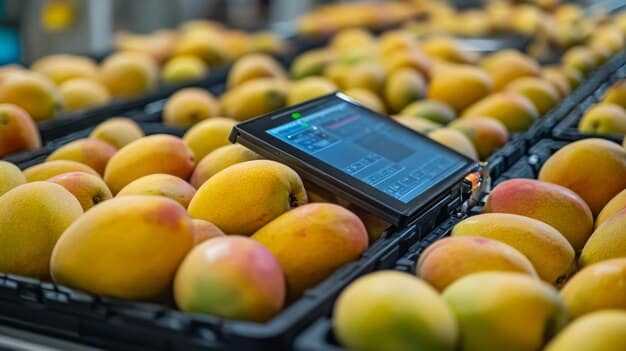
Carrefour’s blockchain food traceability
Carrefour, a major European retailer, has also adopted blockchain technology to track a variety of products, including chicken, eggs, and milk. By scanning a QR code on the product packaging, consumers can access information about the product’s origin, production methods, and transportation history. This has helped Carrefour build trust with its customers and differentiate its products in the marketplace.
They implemented this to achieve:
- Increased customer trust: Providing transparent product information.
- Enhanced brand reputation: Differentiating products through traceability.
- Improved supply chain management: Optimizing processes and reducing waste.
Other notable examples
Several other companies and organizations are exploring the use of blockchain in agriculture. These include:
- Bühler and Givaudan: Working together to create a blockchain platform for tracking cocoa beans from farm to chocolate bar.
- The World Wildlife Fund (WWF): Using blockchain to combat illegal fishing and promote sustainable seafood.
These case studies highlight the diverse applications of blockchain in agriculture and its potential to transform the food industry.
In conclusion, successful blockchain implementations such as Walmart’s mango traceability and Carrefour’s food tracking demonstrate the technology’s potential to enhance transparency, build consumer trust, and transform the food industry.
The future of blockchain in agriculture
As blockchain technology continues to evolve, its potential applications in agriculture will likely expand. From precision agriculture to supply chain finance, blockchain has the potential to transform many aspects of the agricultural sector.
Let’s explore what the future may hold.
Emerging trends and innovations
One emerging trend is the use of blockchain in precision agriculture. By combining blockchain with IoT (Internet of Things) devices, farmers can collect and share data about soil conditions, weather patterns, and crop health. This data can be used to optimize irrigation, fertilization, and pest control, leading to increased yields and reduced environmental impact.
Here’s what else to expect:
- IoT integration: Combining blockchain with sensors and devices.
- Smart contracts: Automating agreements between parties.
- Supply chain finance: Streamlining payments and reducing risk.
Government and industry initiatives
Governments and industry organizations are also playing a key role in promoting the adoption of blockchain in agriculture. For example, several countries are exploring the use of blockchain to improve food safety and traceability. Additionally, industry consortia are working to develop common standards and protocols for blockchain in agriculture.
These initiatives include:
- Regulatory frameworks: Developing clear legal guidelines.
- Pilot programs: Testing and validating blockchain solutions.
- Industry collaboration: Working together to promote adoption.
These efforts are crucial for creating a supportive ecosystem for blockchain in agriculture.
In conclusion, the future of blockchain in agriculture points towards expanded applications, from precision farming to supply chain finance, supported by government initiatives and industry collaborations, promising more efficient, sustainable, and transparent food systems.
| Key Aspect | Brief Description |
|---|---|
| 🌱 Traceability | Track products from farm to consumer, ensuring food safety. |
| 📊 Transparency | Provide consumers with verifiable product information. |
| 💰 Efficiency | Streamline processes and reduce fraud in supply chains. |
| 💡 Innovation | Enable precision agriculture and sustainable practices. |
Frequently Asked Questions
▼
Blockchain is a decentralized, distributed digital ledger that records transactions across many computers. It ensures security and transparency by linking blocks of data in a chain, making alterations difficult.
▼
Blockchain creates an immutable record of a product’s journey from farm to consumer. Each transaction is added to a block, providing a transparent and traceable history of the product.
▼
Challenges include high implementation costs, the need for standardized protocols, scalability issues, and the lack of clear regulatory frameworks. Education and technical expertise are also crucial for successful adoption.
▼
Yes, small farmers can benefit by gaining access to transparent supply chains, building trust with consumers, and differentiating their products in the market. Collective efforts and subsidies can ease implementation costs.
▼
Examples include Walmart tracking mangoes, Carrefour tracing chicken, eggs, and milk, and the WWF using blockchain to combat illegal fishing. These cases demonstrate enhanced traceability and transparency.
Conclusion
In conclusion, blockchain technology in agriculture: Enhancing traceability and transparency in the food supply chain holds substantial promise for transforming the sector. While challenges exist, the potential benefits of increased transparency, improved traceability, and greater efficiency make it a technology worth exploring and investing in for a more sustainable and trustworthy food system.

